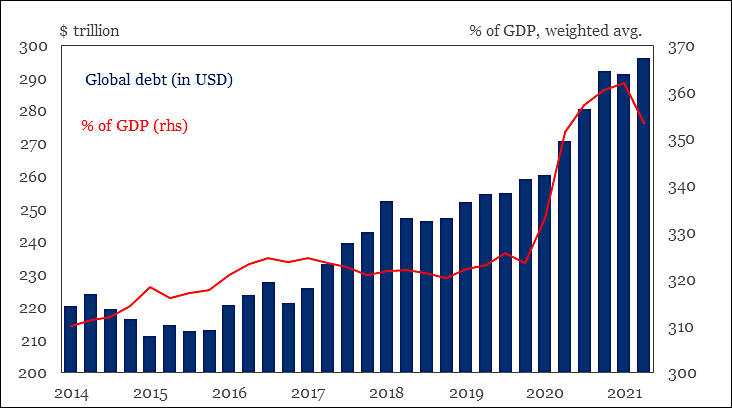
It allows to keep PV going, with more focus towards AI, but keeping be one of the few truly independent places.
-

In the second quarter of 2021, the volume of global debt reached $ 296 trillion, follows from the results of a report published last week by the Institute of International Finance (IIF). Over the quarter, this figure increased by $ 4.8 trillion, and over the past 18 months, i.e., since the beginning of the pandemic, by $ 36 trillion.
The largest contributors to the rise in global debt in the second quarter were developing countries, which borrowed $ 3.5 trillion and brought their total financial liabilities to nearly $ 92 trillion. China borrowed faster than other developed countries, whose total debt, with the exception of China, reached a new record of $ 36 trillion.
The debt of developed countries, especially in the Eurozone, began to rise again in the second quarter after a slight decline in the first.
US debt in the last reporting period rose by $ 490 billion, which was a record low quarterly value since the start of the pandemic. At the same time, household debts grew at a record pace.
The total debt of global households rose by $ 1.5 trillion in the second quarter to $ 55 trillion. In the first half of the year, IIF recorded an increase in household debt burden in almost a third of the countries studied.

 sa18338.jpg732 x 408 - 57K
sa18338.jpg732 x 408 - 57K
Howdy, Stranger!
It looks like you're new here. If you want to get involved, click one of these buttons!
Categories
- Topics List23,992
- Blog5,725
- General and News1,354
- Hacks and Patches1,153
- ↳ Top Settings33
- ↳ Beginners256
- ↳ Archives402
- ↳ Hacks News and Development56
- Cameras2,367
- ↳ Panasonic995
- ↳ Canon118
- ↳ Sony156
- ↳ Nikon96
- ↳ Pentax and Samsung70
- ↳ Olympus and Fujifilm101
- ↳ Compacts and Camcorders300
- ↳ Smartphones for video97
- ↳ Pro Video Cameras191
- ↳ BlackMagic and other raw cameras116
- Skill1,960
- ↳ Business and distribution66
- ↳ Preparation, scripts and legal38
- ↳ Art149
- ↳ Import, Convert, Exporting291
- ↳ Editors191
- ↳ Effects and stunts115
- ↳ Color grading197
- ↳ Sound and Music280
- ↳ Lighting96
- ↳ Software and storage tips266
- Gear5,420
- ↳ Filters, Adapters, Matte boxes344
- ↳ Lenses1,582
- ↳ Follow focus and gears93
- ↳ Sound499
- ↳ Lighting gear314
- ↳ Camera movement230
- ↳ Gimbals and copters302
- ↳ Rigs and related stuff273
- ↳ Power solutions83
- ↳ Monitors and viewfinders340
- ↳ Tripods and fluid heads139
- ↳ Storage286
- ↳ Computers and studio gear560
- ↳ VR and 3D248
- Showcase1,859
- Marketplace2,834
- Offtopic1,320




